COLUMBIA, Mo. – The weather played a part in cutting the pumpkin crop this year. It was just too wet in the Midwest.
“The pumpkin supply is not good this year,” said David Trinklein, horticulture specialist for University of Missouri Extension. “Missouri farmers who were able to plant pumpkins and keep them from drowning this year will be rewarded with higher prices.”
With pumpkin prices on the rise, smart consumers might want this Halloween fruit to do double duty.
“If you carve it and use it as a jack-o’-lantern, it shouldn’t be cooked,” said Tammy Roberts, nutrition specialist for MU Extension. “But if you want to paint it with nontoxic paints for the Halloween holiday, you can then cook any pumpkin that you buy.”
Cooking pumpkin
Even though pumpkins are separated into two groups – those for cooking and those for jack-o’-lanterns – both kinds can be cooked and eaten, Roberts says.
“Choose a pumpkin that is a good solid orange color and with skin that can’t be easily broken or scratched by your fingernail.”
When ready to cook the pumpkin, remove the stem and cut the pumpkin in half.
“You can bake it, microwave it or boil it,” she says.
To bake, put the cut side down on a baking sheet and bake at 350 degrees until the pumpkin is fork-tender, or for about an hour. In the microwave, put the cut side down on a microwave-safe plate and cook for about 15 minutes.
To boil the pumpkin, cut it into chunks, then rinse the chunks in cold water and place them in a large pot in an inch of water. Cover the pot and boil for about 20-30 minutes, Roberts says.
Don’t try to peel the pumpkin before cooking, she says. After the pumpkin flesh is tender, it can be easily scraped away from the skin.
“Once it’s soft, you’ll want to make the puree for use in pies, cakes, soups and stews,” Roberts says. “Just cool it, peel it and then use a food processor, a blender, a ricer or a potato masher to make the puree.” Every pound of whole pumpkin will produce a cup of puree.
Roberts says this healthy vegetable is really worth the effort.
“When you eat pumpkin, you get vitamin A, potassium, protein and vitamin C. The other good thing is pumpkin is low in calories.”
Any unused puree can be frozen and stored for up to a year. Pumpkin puree cannot be canned.
“It’s because of the thickness of the puree,” Roberts says. “It’s hard to get the internal temperature that’s needed to preserve it correctly.”
A little pumpkin history
The tradition of carving faces into a vegetable started in Europe.
“For All Hallows’ Eve in Europe, grotesque faces were carved into hollowed-out turnips with a candle set inside,” Trinklein said. “For whatever reason, that morphed into a pumpkin in the United States.”
Pumpkins have been grown in the Americas for 5,000 years and were a widely used food source for Native Americans by the time the early European explorers arrived in North America, he said.
Nutritious and easy to cook, pumpkin should be recognized as more than just a holiday decoration.
“I would be willing to venture that 99 percent of all pumpkins never see the inside of an oven,” Trinklein said. “They’re just discarded, which is a real shame.”
For more information from MU Extension:
“Pumpkin: A Brief History” (Missouri Environment & Garden, Oct. 2013), http://ipm.missouri.edu/MEG/2013/10/Pumpkin-A-Brief-History.
“Many Uses for Pumpkin” (MissouriFamilies feature article), http://missourifamilies.org/features/nutritionarticles/nut199.htm.
Read more http://extension.missouri.edu/news/DisplayStory.aspx?N=2655






